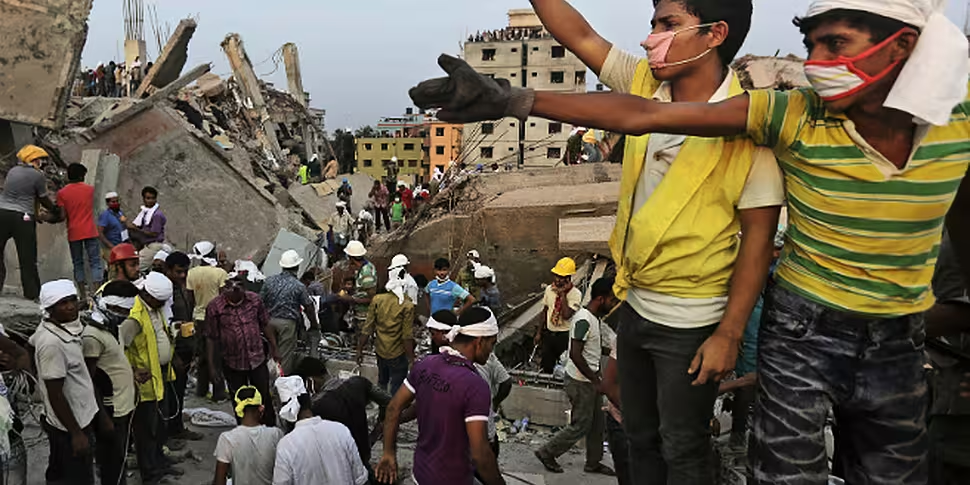On April 24, 2013, after 19 days of searching through rubble, rescue workers at the Rana Plaza site declared the death toll to be 1,134. Officially, the collapse of the textile factory in Dhaka, Bangladesh was now the single deadliest garment-factory disaster in history.
It was, of course, an avoidable tragedy. A day earlier, loud explosion-like sounds led to an engineer inspecting the complex, which held clothing factories, several shops, a bank and apartments. Observing cracks in support pillars, he insisted on a full and immediate evacuation.
The bank ordered employees to vacate soon after. However, a number of factory managers ignored the warnings – one, Ether Textiles, threatened to withhold a month’s pay for any absent workers.
Later, an examination of records would show that the building had been with built without authorisation on a pond; converted from commercial to industrial use; had three floors added without permit; and was built from sub-standard materials.
At 8.57am the building collapsed. 3,890 workers were inside - mostly women, and also a number of children in nursery facilities. Of the eight stories visible the day before, only the ground floor remained intact.
Many of the survivors, some trapped for days in the rubble, were left traumatised, and disfigured, and unable to provide for themselves or their families.
As news of the horror spread, calls were made by governments and NGOs worldwide to address the abysmal working conditions of those who make clothes for some of the world’s leading fashion brands.
Primark, Benetton, Walmart, JC Penney, Kappa, Mango and Matalan were all found to be linked to the factories operating in Rana Plaza.
In January 2014 the UN’s International Labour Organisation established the Rana Plaza Donors Trust Fund to gather compensation for victims of the disaster. Its committee includes representatives from Bangladeshi government and industry, global brands and retailers, and Bangladeshi and international trade unions and NGOs.
Amongst them, an agreement was made that donations should reflect a company’s ability to pay, the size of their relationship with Bangladesh and the extent of their relationship with Rana Plaza. Though brand representatives refused to set specific payment amounts for each company, a figure of $30m in total compensation was set.
Now, as we pass the second anniversary of the disaster, the claims process is almost complete, but many brands have yet to pay up their share to the victims.
Donations thus far are recorded on the website on the website of the Clean Clothes Campaign (CCC)
The CCC has said the “nearly every brand linked to the Rana Plaza building has made insufficient donations, thus failing to live up to their responsibilities to the victims.”
“We need to start asking questions as to why out of all the companies with direct links to Rana Plaza only two – Primark and Loblaw - have stepped up in a financially meaningful way, showing that they take their responsibilities seriously, and that they do respect the lives of workers,” says representative Kate Nolan.
“If all the other companies involved had followed suit, we would not be... still facing over a four million shortfall.”
According to the Clean Clothes Campaign, Benetton is the “only international brand with confirmed links to the Rana Plaza factories which has refused to contribute a single penny to the Rana Plaza Donors Trust Fund.” Of its parent company’s €139m profits (2013), CCC is asking that the brand donates €5m.
A number of protesters held a peaceful demonstration at the Benetton store in the St Stephen’s Green Shopping Centre on April 23, which was co-ordinated with similar demonstrations internationally.
In Dhaka, the site itself remains largely untouched, with only a small concrete statue marking the significance of the vacant plot. The monument was erected by survivors, family members and activists, despite police efforts to prevent it.
Though campaigners have argued the land should be sold to contribute to a victims' fund, or used to provide them housing, it remains in limbo as owner Sohel Rana remains in prison.
The compensation agreed by the ILO is sorely needed by those impacted by the disaster. Many former workers continue to find themselves discriminated against, with factory managers unwilling to employ them as they are likely to be less efficient workers.
Locals have little confidence that attitudes to labour conditions have changed, with the Bangladeshi government proving intransigent at best and aggressive at worst - multiple protests after the disaster were met with police violence.
There is much work to be done to improve the working conditions of Banglasdeshi labourers - by fashion brands, governments and unions - and it must start by compensating the victims of Rana Plaza in full.









